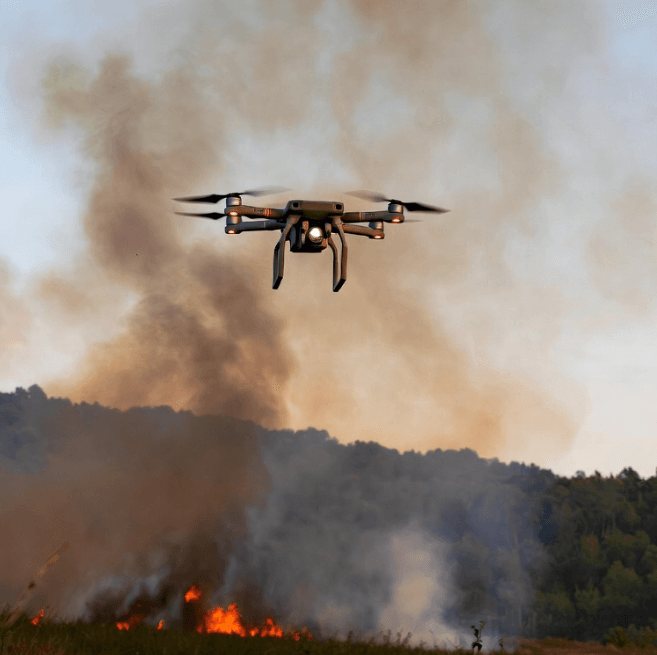One issue that frequently comes up in drone inspection, robotics, and emergency response is how to continue having accurate perception when visibility is reduced by smoke, fog, dust, or fire.
RGB cameras and artificial intelligence perception are examples of vision-based systems that work well in clear environments but quickly deteriorate in dense smoke or haze. However, mmWave radar continues to provide consistent sensing output, making it indispensable for any mission that places a high priority on dependability and safety.
For applications involving drones, robotics, or low-visibility environments, you can refer to the radar solutions overview on Linpowave’s mmWave radar product page to see how these sensors are deployed across industries.
Why Smoke and Dust Have No Effect on mmWave Radar
Strong Penetration Is Provided by Longer Wavelengths
Because visible light wavelengths are so small, they are extremely susceptible to being scattered by dust or smoke particles. As a result, details are lost and images become washed out.
The frequencies at which mmWave radar operates—24 GHz, 60 GHz, or 77 GHz—have wavelengths that are noticeably longer than those of airborne particles. The indication
-
distributes less
-
reduces attenuation
-
more successfully penetrates fog and smoke
Because of this, mmWave radar continues to work even in cases where visual systems are almost completely blind.
Regardless of the Illumination
Cameras have trouble with:
-
dim lighting
-
Darkness
-
backlighting
-
lighting that changes quickly
mmWave radar operates as an active sensor. Because it doesn't depend on ambient light, it can maintain stable perception even in complete darkness or dense smoke, which is essential for emergency robots or drones.
Measurements of the body remain constant.
Noise, blur, and missing edges all impair vision.
Radar takes direct measurements:
-
distance
-
velocity
-
angle
-
4-dimensional point clouds (for high-resolution radar)
This significantly improves the reliability of its output in degraded environments.
Real-world scenarios in which radar outperforms vision.
Firefighting and dense smoke
Fast-moving, layered smoke is produced during fire scenes. Cameras typically fail almost immediately.
Drones equipped with mmWave radar can:
-
navigate
-
steer clear of obstacles.
-
Maintain a stable position
even when visibility is completely obscured.
Air mobility and fog in urban areas
Fog and haze reduce camera contrast and destabilize optical algorithms. Radar technology continues to provide long-range detection, assisting drones and eVTOL systems in maintaining safe low-altitude flight.
Dust-filled industrial environments
Camera systems are routinely tested in mining, chemical plants, and tunnel construction projects. Radar remains reliable, providing continuous safety monitoring and autonomous navigation.
Monitor wildfires
Visual sensors degrade quickly in forest fire scenarios, whereas radar can continue to detect falling trees, moving objects, and structural collapse hazards.
Radar and vision Collaboration improves performance
Radar is not meant to replace vision; rather, it is meant to complement it.
| Capability | Vision | mmWave Radar |
|---|---|---|
| Stability with smoke and fog | Low | High |
| Resolution | Significantly high | Medium to high |
| Range Accuracy | Moderate | High |
| Light Sensitivity | High | None |
| Night Operation | Limited | Excellent |
| Occlusion Handling | Weak | Strong |
Safer and more dependable navigation systems are produced by combining radar and vision.
To see examples of multi-sensor systems, you can explore Linpowave's application pages, which outline how radar enhances drone and robotics perception in real-world deployments.
Selecting the Appropriate Radar
Moderate to Light Smoking
Standard radars operating at 77 GHz are adequate.
Dense Smoke or Fire
The benefits of 4D imaging radar
-
improved resolution of angles
-
increased cloud density at the point
-
enhanced separation between objects
Broad-Based Surveillance
Large areas like tunnels or wildfire zones can be covered by networking several radars.
Summarization
In dust, smoke, and fog, camera-based perception has intrinsic limitations. mmWave radar, featuring:
-
Wavelengths longer
-
autonomous lighting
-
consistent ranging capabilities
maintains dependability in the event that vision systems malfunction.
As autonomous robotics, emergency response, and low-altitude logistics continue to expand, mmWave radar will become more crucial for dependable sensing and safe navigation.
To explore mmWave radar solutions for drones, industrial robotics, and low-visibility environments, visit the official product overview at Linpowave.com.
FAQ
Does heavy smoke completely impair the performance of mmWave radar?
With only slight attenuation, it is still far more stable than vision, though not entirely.
Does the range of radar detection decrease in fog?
Radar continues to function dependably over long distances, albeit slightly.
Is mmWave radar resistant to fire conditions with high temperatures?
Even though industrial radars can withstand high temperatures, protective housing is still necessary in extremely hot conditions.
Can drone obstacle avoidance be handled by radar alone?
It can, but the maximum safety margin is offered by radar + vision fusion.
What are the advantages of fusing radar and vision?
In both clear and degraded environments, it maintains reliability, increases robustness, and decreases false detections.



